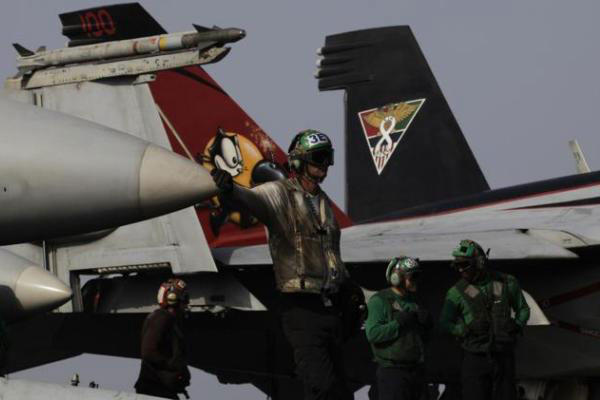The United States has pledged to destroy Islamic State extremists operating in Iraq and Syria, but experts maintain that America's cash-strapped military shouldn't expect any extra money to fight this new foe.
President Obama announced Friday that the U.S. and NATO would launch a military campaign to break up the terrorist network known as the Islamic State of Iraq and the Levant.
The U.S. military has already carried out more than 100 airstrikes against ISIL in northern Iraq to bolster Iraqi and Kurdish military forces. But so far this has been a containment strategy that the U.S. can no longer afford to follow, he said.
"The goal has to be to dismantle them," Obama said at the close of his NATO meeting in Wales.
This mission poses a new challenge to a shrinking U.S. military that's been forced to absorb deep defense spending cuts under sequestration.
The Pentagon has been immersed in what's known as the "Pacific Pivot," or the rebalance of the U.S. military to the Asia-Pacific region. Now the mission of defeating ISIL comes on top of Russian aggression in Ukraine, a smoldering threat that has forced the United States to promise support for a new Rapid Response Force of several thousand troops with headquarters in Eastern Europe to protect NATO member states against future aggression.
The bulk of the U.S. military's mission in Afghanistan will soon come to an end, but budget caps under sequestration have forced the services to cut training money, a move the service chiefs have warned is already causing readiness to deteriorate. The Army has adopted a strategy that focuses on near-term readiness, an approach that will restrict training for many combat units, shrink aviation assets and delay high-priority modernization efforts.
With the threat of more sequestration cuts in 2016, service leaders have also been warning Congress that the U.S. military -- particularly the Army -- will become too small to handle a combined fight like Iraq and Afghanistan in the future.
The Pentagon's fiscal 2015 defense budget will reduce the active force from 490,000 to a force size of 440,000 to 450,000 by 2019. Sequestration cuts scheduled to occur in 2016 will likely force the Army to reduce the active end strength to 420,000.
The overall U.S. economy has recovered considerably, but military budget experts maintain that it's unlikely that Congress or the White House will repeal sequestration, according to Todd Harrison, a senior fellow at the Center for Strategic and Budgetary Assessments, a nonpartisan Washington think tank.
"For the military the pressure is not letting up; the services are still warning that they have readiness shortfalls," Harrison said. "If the budget caps under sequestration continue, then we will continue to have budget shortfalls."
In fact, the Pentagon stands to be up to $300 billion short of what's needed to enact the nation's official defense strategy in coming years if sequestration continues, Harrison argues in a recent report.
Harrison's analysis doesn't include the demands of new and intensified conflicts in places such as Ukraine or Iraq. Since June, the U.S. has spent some $600 million on limited airstrikes and an advisory mission aimed at halting ISIL's advance.
But Lawrence Korb, a senior fellow at the Center for American Progress, argues that the fiscal 2015 defense budget contains the money in the Overseas Contingency Operations account to deal with threats like ISIL.
"The war funding budget they set up this year ... that's got an awful lot of extra money," Korb said.
The $58 billion OCO account is down significantly from $85 billion in fiscal 2014's budget. But there is new money - about $4 billion - known as the Counter Terrorism Partnerships Fund that's designed for threats like ISIL, Korb said.
It's still unclear how aggressively the U.S. plans to attack ISIL, but Obama said the NATO meeting in Wales showed "unanimity that ISIL poses a significant threat to NATO members."
Such a campaign is likely affordable as long as a large numbers of ground troops -- and the logical tail need to support them - doesn't become part of the equation, Harrison said.
"You could ratchet up the air operations; the more sorties you fly the more it is going to cost," Harrison said. "Certainly if we expand more operations into Syria, we are covering more area. You would need more [intelligence, surveillance and reconnaissance] flights. There would be more targets, there would be more strike missions as well, but that would be scaling linearly with what we are already doing."
Many in Washington blame reoccurring deficit problems on entitlement programs such as Social Security, Medicare and Medicaid, Korb said, but modern war is an expensive venture that rarely comes out of the average American's wallet.
"In 1968 we had 500,000 troops in the ground in Vietnam, and we had a balance budget," Korb said. "Ya know why? We had a war surtax."
The first Gulf War cost the United States practically nothing, Korb said.
"We told the world ... either you send troops or you send money, and we actually got so many contributions we actually had a profit," he said.
America's longest war has been quite a bit different.
"When we went to war in Afghanistan and Iraq not only did we not raise taxes, we actually cut them," Korb said, describing how military officials talk about the unlimited amount of money available to them during a decade of war.
"When you talk to people they say 'we didn't have to make any hard choices. We just had everything we wanted.'"
Korb said he's currently writing an article that will say to Congress "if you want to go to war in Syria ... then vote for it, and put a tax on it."
-- Matthew Cox can be reached at Matthew.Cox@monster.com
Don't Miss a Single Military.com Story
To read the full article and get exclusive benefits, sign up today.
It’s FREE
Why am I seeing this? Visit our FAQs


























